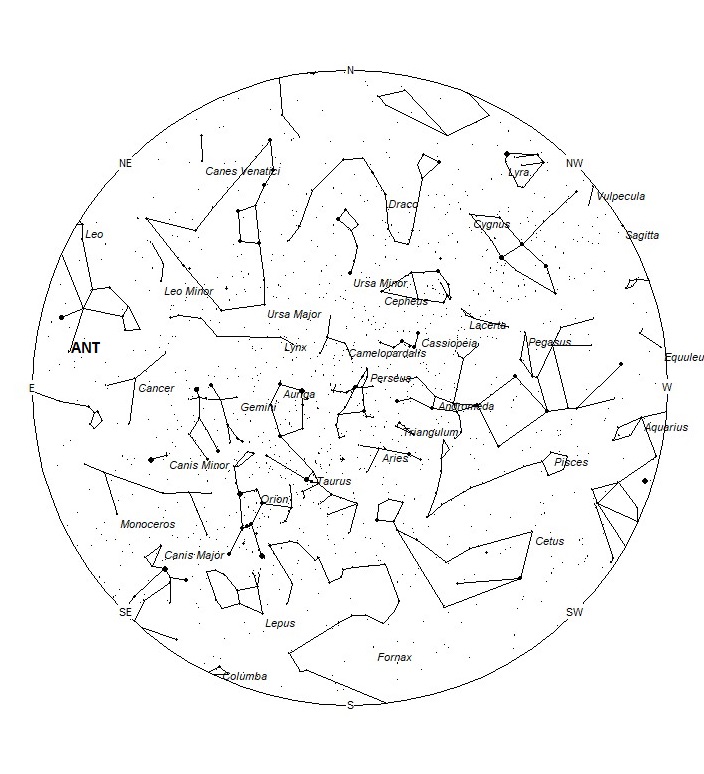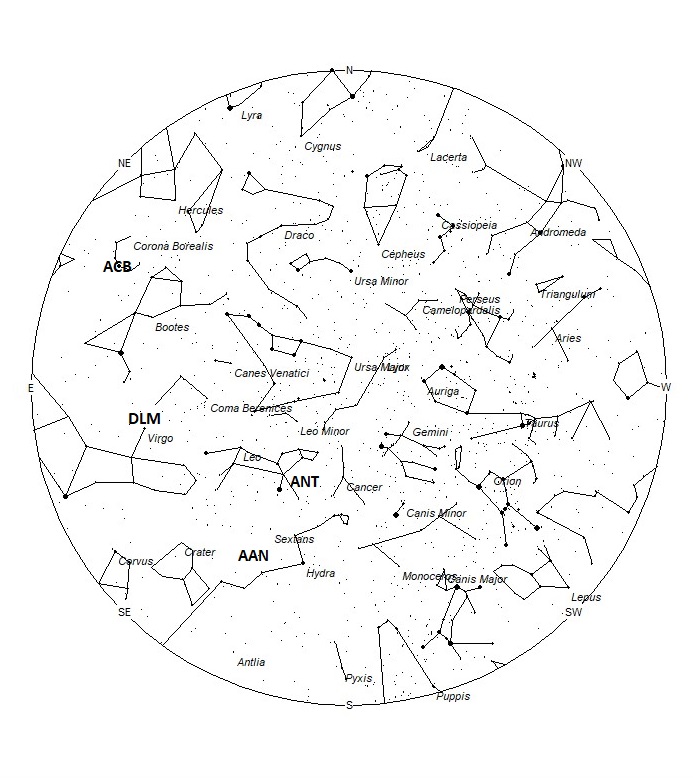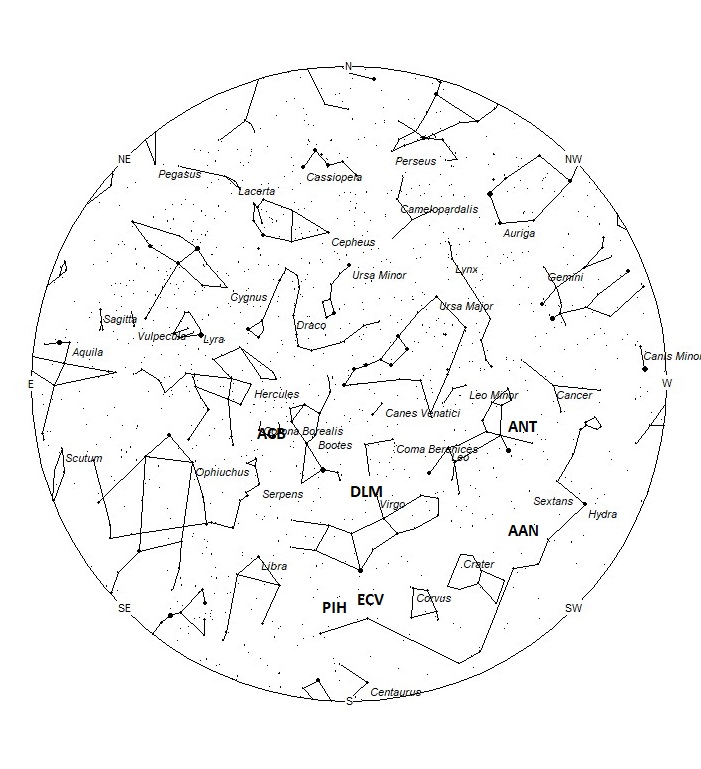During this period, the moon reaches its new phase on Tuesday February 1st. At that time the moon lies near the sun and is invisible at night. This weekend the thin crescent moon will rise during the early morning hours and will not interfere with meteor observing. The estimated total hourly meteor rates for evening observers this week is near 2 as seen from mid-northern latitudes (45N) and 3 as seen from tropical southern locations (25S). For morning observers, the estimated total hourly rates should be near 10 as seen from mid-northern latitudes (45N) and 12 as seen from tropical southern locations (25S). The actual rates will also depend on factors such as personal light and motion perception, local weather conditions, alertness, and experience in watching meteor activity. Note that the hourly rates listed below are estimates as viewed from dark sky sites away from urban light sources. Observers viewing from urban areas will see less activity as only the brighter meteors will be visible from such locations.
The radiant (the area of the sky where meteors appear to shoot from) positions and rates listed below are exact for Saturday night/Sunday morning January 29/30. These positions do not change greatly day to day so the listed coordinates may be used during this entire period. Most star atlases (available at science stores and planetariums) will provide maps with grid lines of the celestial coordinates so that you may find out exactly where these positions are located in the sky. I have also included charts of the sky that display the radiant positions for evening, midnight, and morning. The center of each chart is the sky directly overhead at the appropriate hour. These charts are oriented for facing south but can be used for any direction by rotating the charts to the desired direction. A planisphere or computer planetarium program is also useful in showing the sky at any time of night on any date of the year. Activity from each radiant is best seen when it is positioned highest in the sky, either due north or south along the meridian, depending on your latitude. It must be remembered that meteor activity is rarely seen at the radiant position. Rather they shoot outwards from the radiant, so it is best to center your field of view so that the radiant lies at the edge and not the center. Viewing there will allow you to easily trace the path of each meteor back to the radiant (if it is a shower member) or in another direction if it is sporadic. Meteor activity is not seen from radiants that are located far below the horizon. The positions below are listed in a west to east manner in order of right ascension (celestial longitude). The positions listed first are located further west therefore are accessible earlier in the night while those listed further down the list rise later in the night.
These sources of meteoric activity are expected to be active this week.
The large Anthelion (ANT) is currently centered at 09:32 (143) +14. This position lies in western Leo, 8 degrees northwest of the 1st magnitude star known as Regulus (alpha Leonis). Due to the large size of this radiant, these meteors may also be seen from Cancer as well as western Leo. This radiant is best placed near 01:00 local standard time (LST) when it lies on the meridian and is highest in the sky. Rates at this time should be near 3 per hour as seen from the northern hemisphere and 2 per hour as seen from south of the equator. With an entry velocity of 30 km/sec., the average Anthelion meteor would be of slow velocity.
The alpha Antliids (AAN) were discovered by D. P. Galligan and W. J. Baggaley by using the Advanced Meteor Orbit Radar in New Zealand*. This very weak display is active from January 20 through February 10. There are two weak maximums occurring near January 26 and February 1. The radiant lies at 10:22 (156) -09. This position lies in southern Sextans, east of the faint star known as epsilon Sextantis. I’m not certain why these meteors were called alpha Antliids as this position lies 20 degrees north of the constellation of Antlia. These meteors are best seen near 0200 LST when the radiant lies highest above the horizon. At 44 km/sec. the alpha Antliids produce meteors of medium velocity. Expected rates this week are less than 1 per hour no matter your location.
*Gary Kronk, Meteor Showers-An Annotated Catalog, 2nd Edition Page 45
The December Leonis Minorids (DLM) is a shower of long duration active from December 1st all the way through February 10th. Maximum occurred near December 19th when rates may have reached 3 an hour. During this period, I would expect hourly rates of less than 1 from a radiant located at 13:08 (197) +12. This position lies in northern Virgo, 2 degrees northeast of the 3rd magnitude star known as Vindemiatrix (epsilon Virginis). These meteors are best seen near 0500 LST when the radiant lies highest above the horizon. At 63 km/sec. the December Leonis Minorids produce mostly swift meteors. At this time of year, these meteors are synomous with the February epsilon Virginids.
The eta Corvids (ECV) were recently discovered by Sirko Molau and the IMO Video Meteor Network Team. This stream is active from January 7-February 5, with maximum activity occurring on January 21st. The current position of the radiant is 13:13 (198) -19, which places the radiant in southern Virgo, 4 degrees north of the 3rd magnitude star known as gamma Hydrae. These meteors are best seen near 0500 LST when the radiant lies highest above the horizon. Current hourly rates would be less than 1 per hour no matter your location. At 68 km/sec. these meteors would be fast.
The alpha Centaurids (ACE) are active from February 3-20, with maximum activity occurring on February 9th. The radiant is currently located at 13:13 (198) -55. This position lies in southern Centaurus, 4 degrees southwest of the 2nd magnitude star known as epsilon Centauri. Due to the southern declination of this radiant, these meteors are not well seen in the northern hemisphere. Current hourly rates are expected to be less than 1 no matter your location. These meteors are best seen near 05:00 LST when the radiant lies highest above the horizon. At 56 km/sec. the alpha Centaurids would produce mostly swift meteors.
The pi Hydrids (PIH) were discovered in Dr. Peter Jenniskens and mentioned in his book Meteor Showers and their Parent Comets. Studies of the IMO video database by Sirko Molau and Juergen Rendtel confirmed the existence of this shower. These meteors are active from February 3-9, which maximum activity occurring on the 6th. The radiant is currently located at 13:43 (206) -20. This area of the sky is located in extreme southeastern Virgo, 8 degrees northwest of the 3rd magnitude star known as pi Hydrae. These meteors are best seen during the last dark hour prior to dawn when the radiant lies highest above the horizon in a dark sky. Current rates are expected to be less than 1 per hour no matter your location. These meteors are visible over most of the Earth, with the southern hemisphere having slightly better viewing conditions. At 55 km/sec. the pi Hydrids would produce mostly swift meteors.
The alpha Coronae Borealids (ACB) were discovered by John Greaves using data from SonotoCo. Activity from this source spans from January 26 to February 5 with maximum activity occurring on January 27. The radiant is currently located at 15:34 (234) +26. This position lies in in southern Corona Borealis, near the spot occupied by the 3rd magnitude star known as Alphecca (alpha Coronae Borealis). These meteors are best seen during the last few hours before dawn, when the radiant lies highest in a dark sky. Current rates should be less than 1 per hour no matter your location. These meteors encounter the atmosphere at 58 km/sec., which would produce meteors of swift velocity.
As seen from the mid-northern hemisphere (45N) one would expect to see approximately 7 sporadic meteors per hour during the last hour before dawn as seen from rural observing sites. Evening rates would be near 2 per hour. As seen from the tropical southern latitudes (25S), morning rates would also be near 10 per hour as seen from rural observing sites and 3 per hour during the evening hours. Locations between these two extremes would see activity between the listed figures. Evening rates are reduced by moonlight during this period.
You can keep track of the activity of these meteor showers as well as those beyond the limits of visual observing by visiting the NASA Meteor Shower Portal available at: https://meteorshowers.seti.org/ You can move the sky globe to see different areas of the sky. Colored dots indicate shower meteors while white dots indicate sporadic (random) activity. The large orange disk indicates the position of the sun so little activity will be seen in that area of the sky.
| SHOWER | DATE OF MAXIMUM ACTIVITY | CELESTIAL POSITION | ENTRY VELOCITY | CULMINATION | HOURLY RATE | CLASS |
| RA (RA in Deg.) DEC | Km/Sec | Local Standard Time | North-South | |||
| Anthelions (ANT) | — | 09:32 (143) +14 | 30 | 01:00 | 3 – 2 | II |
| alpha Antliids (AAN) | Feb 01 | 10:22 (156) -09 | 44 | 02:00 | <1 – <1 | IV |
| December Leonis Minorids (DLM) | Dec 19 | 13:08 (197) +12 | 63 | 05:00 | <1 – <1 | II |
| eta Corvids (ECV) | Jan 21 | 13:13 (198) -19 | 68 | 05:00 | <1 – <1 | IV |
| alpha Centaurids (ACE) | Feb 09 | 13:13 (198) -55 | 56 | 05:00 | <1 – <1 | II |
| pi Hydrids (PIH) | Feb 06 | 13:43 (206) -20 | 55 | 06:00 | <1 – <1 | II |
| alpha Coronae Borealids (ACB) | Jan 27 | 15:34 (234) +26 | 58 | 08:00 | <1 – <1 | IV |




